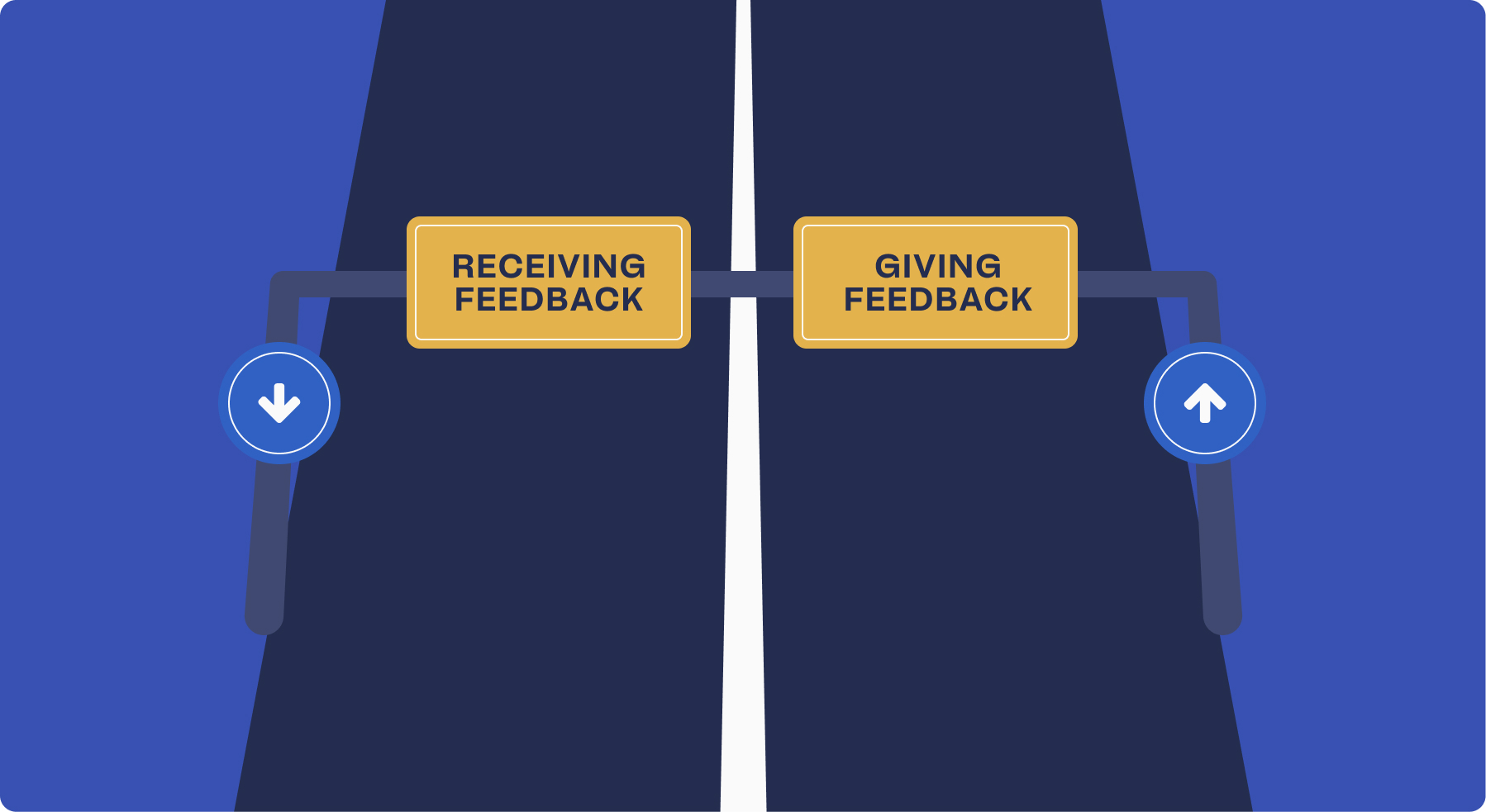In my four years of working as an Engineering Manager, the one thing my reports never seem to have enough of is feedback. The funny thing is, they’re rarely ready to give feedback, especially when it’s not positive, and they often react poorly to constructive feedback when they receive it.
Feedback is a slippery slope. Even when we see its benefits and want to use it in the best way possible, our internal blockers often sabotage both how we give it and how we react to it. So, if my amazing team struggles with this, it’s logical to assume they’re not the only ones, and that this is a very common issue.
You can find a million blogs full of do’s and don’ts, step-by-step recipes for giving and receiving feedback, and don’t get me wrong, that’s perfectly fine. But why do we so often skip over the real underlying issue? If you don’t have the right perspective and mindset, you can have all the cheat sheets in the world, and they still won’t help you, not really.
The Real Reason Feedback is Hard
So let’s go back to basics: why is it so hard to give someone feedback? We’ve all been taught some version of that famous line: “If you don’t have anything nice to say, don’t say anything at all.” And then, when we get to school, we all learn what happens to snitches…
When you think about it, we’ve spent our whole lives absorbing the message, from everyone around us, that nothing good comes from saying something “bad” about someone else. The only exception? Gossip. Talking about someone behind their back is somehow seen as harmless, even a bit of fun.
But how is venting over lunch or coffee about what someone did wrong better than simply telling them directly, giving them a chance to explain their reasoning and giving them information that could actually help them grow and improve?

A New Perspective: Feedback as Kindness
That’s what I mean when I say that the first thing we have to change is our perspective on feedback.
What possibilities open up when we start thinking about feedback as an act of kindness, a way to help someone see how they’re perceived, to reveal blind spots, to offer a fresh perspective? What would happen if we stopped assuming people are lazy, careless, or incompetent, and instead recognized that most of us are just doing the best we can with the information we have?
Wouldn’t it be helpful to give that extra bit of insight so they can improve on their best efforts? And wouldn’t it be nice if, one day, someone did the same for us, without us assuming they’re just trying to tear us down?
“The sound of our entire perspective on feedback crashing down. (If you’re not sure what that sounds like, think glass shattering. Very dramatic.)”
I know it’s a lot, give it a minute to sink in.
The Best Career Investment is in Yourself
My most consistent piece of advice for my team, rooted in my own experience leading teams and focusing on personal growth, is that the best investment you can make in your career is in yourself.
I learned this one the other way around. Who would have thought that going to therapy and working on personal growth would have such huge benefits in my work life? Happy little accidents.
Recognizing my triggers, regulating my emotions, and resisting black-and-white thinking have helped me more than any technical skill I’ve picked up at work. And this is valuable for everyone, not just those aiming for management or leadership roles.
Yes, yes, we’re back to feedback again. But think about it: how much more could you get out of feedback if your triggers weren’t all firing, and you could actually listen and hear what someone is saying?
Even though I approached it from the personal side first, you can flip it: if you lack motivation to work on yourself, think of it as investing in your professional growth. The “happy little accident” is that skills like emotional regulation and clear communication don’t clock out at 5 PM.
I’d love to keep talking about this,but I’m not a psychologist, so let’s move on to something I’m a bit more qualified for.
10 Rules for More Effective Feedback
Now that we’ve shifted our perspective, let’s talk about those cheat sheets, the steps that make feedback a little less like diving into cold, dangerous waters.
We’ll approach this simply. Think of feedback as a two-way street. And while there are two roles involved, the giver and the receiver, there’s one set of ‘rules of the road’ that applies to everyone, no matter which direction you’re headed.
1. Set your ego aside.
Or at least try. As hippie as it sounds, take a deep breath before it kicks in. Don’t let it ruin your chances for a productive conversation. Even the most fragile ego can handle a couple of constructive notes. And yes, this applies to giving feedback as well.
2. Remember: you’re not enemies.
You’re colleagues. You should have each other’s best interests in mind. Sure, this works best when both people are on board, but if you keep your cool and your perspective clear, you can still walk away a winner even if the other person tries to start a war.
3. Don’t be a “Karen.”
We all know that person who hides behind “I’m just being direct” while serving up straight-up insults. No, Karen, that’s not transparency, that’s being a b**ch.

One of the most important parts of our job is quality communication, whether we’re planning the next feature, deciding project steps, or giving feedback. Being mindful of your tone and words isn’t a luxury, it saves time in the long run. People matter. How they feel matters. And if you want the business case, there are plenty of studies showing people are more productive when they feel valued and respected.
Let’s be clear: this is not about sugarcoating. It’s about delivering a clear message with basic human respect. You can be clear and kind, or you can be clear and rude. Both are choices, but only one of them builds a successful team.
4. Don’t rush important feedback.
If you don’t have time to give quality feedback, postpone it. Sure, some task-specific feedback can be handled with a Slack message. But if it’s critical feedback, give it the time and space it deserves.
5. Listen, really listen.
Remember that simple rule from childhood about not interrupting? Well, it still applies. But active listening is more than just being quiet, it’s about what you do in that silence. It means you’re not spending that time crafting your next brilliant comeback. Instead, your only goal is to understand their perspective, even if you don’t agree with it. That single shift is one of the most powerful communication tools you can develop.
6. Drop assumptions at the door.
Don’t walk in thinking you know the whole story. Keep an open mind and hear the other person out, see what happens, you might be surprised.
7. Don’t make it personal.
This might not be a new idea, you’ve probably heard it a hundred times, but it’s a crucial one. Separate the person from their actions.
For instance, if a team member misses an agreed-upon deadline, instead of charging in and declaring:
“YOU ARE SO LAZY!”
Try:
“I noticed we’re behind schedule on this delivery. Could you walk me through what’s happening? I want to make sure we have what we need to get this back on track.”
With this approach, you’ve expressed concern and left room for their perspective. Gaining a different viewpoint on the issue can be incredibly helpful and allows you to solve the problem together.
So, what’s the biggest catch? You can use all the right words, but if your intention isn’t genuine, you’ll come across as passive-aggressive, which can be even more damaging.
8. Regulate your emotions.
You won’t master this overnight. If you feel triggered, take a break and resume when both of you have cooled down, but make sure you come back to it.
9. Reflect afterward.
Even if you stayed cool and handled the meeting perfectly, your body probably still went into stress mode. Since it doesn’t really know the difference between a lion chasing you, receiving feedback that doesn’t flatter your ego or not knowing how someone will react to your feedback, your blood pressure and heart rate will likely spike, along with your adrenaline levels. That’s why you should set some time aside to reflect on what was said and decide how you want to respond once you’ve calmed down.
10. End on a good note.
Thank them for their time or feedback. Ask clarifying questions if needed. And finally, make sure you both leave with understanding, not resentment.
Final Thoughts: It’s a Work in Progress
Nobody says it’s easy. As a self-professed people pleaser, I’ve found giving feedback to be the hardest skill I’ve had to master so far, and I’m definitely still learning.
We often talk about how hard it is to hear difficult feedback, but for me, it has always been a million times harder to be the one giving it. I’m sure I’m not alone in this. Even when you work on your perspective and have the best intentions, you can never predict how the other person will react. It’s hard to shake off past experiences, and at first, you’ll often feel like the bad guy, as if what you’re doing is somehow wrong or rude.
If there’s a magic formula to make those feelings go away and avoid being misunderstood, please let me know, because I still haven’t found it. What I found helpful is being completely transparent and reminding yourself that you’re trying to do something that benefits the other person. It’s okay for it to be hard sometimes, we’re all a work in progress.
If I could give you one piece of career advice, it would be this: even though it’s difficult, investing your time and energy into improving your feedback skills will pay off in the long run. Good luck, and hey, try not to be a Karen :)



